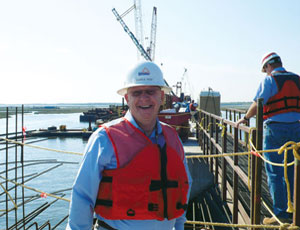Even some of the harshest critics of the U.S. Army Corps of Engineers are pleased by the swift rise of the $1.3-billion Inner Harbor Navigation Canal Lake Borgne Storm Surge Barrier. The 1.8-mile-long, 26-ft-high concrete and steel wall-and-gate structure going up at the confluence of the IHNC, the Gulf Intracoastal Waterway and the Mississippi River Gulf Outlet (MRGO) in New Orleans is designed to keep storm surge on Lake Borgne and the Gulf of Mexico away from the city’s eastern flank.


The wall crosses MRGO, whose deleterious effects on wetlands and levees were cited in U.S. District Court Judge Stanwood Duval Jr.’s much-publicized Nov. 18 ruling that blamed the Corp’s “negligent” operation and maintenance of the waterway for 2005’s flooding of a large part of New Orleans in Hurricane Katrina. The barrier, which the Corps says is its largest design-build, civil-works project ever, helps block MRGO and significantly strengthens flood protection in an area long called the city’s Achilles’ heel. Completion will help the Corps meet its deadline to bring the Greater New Orleans Hurricane and Storm Damage Risk Reduction System to 100-year levels of protection by June 2011.
The job’s production record fails to capture the intricacies of the work or the innovation and skill with which it is being accomplished. With 15 cranes on the water, the endless ballet of technical lifts—involving precision alignment with enormous loads over water and at night—is astounding to observe, say project officials. “None of these lifts are easy,” says Vic Zilmer, the Corps civilian project manager. “They just make them look that way.”
“There is an art to doing this—the art of people who understand how to design things, work the equipment and choreograph it all into a thoughtful operation,” says Charlie Hess, senior vice president of prime contractor Shaw Environmental & Infrastructure Group, Baton Rouge. With a half-million work hours so far, Shaw has no lost-time incidents. “We’ve got a very good team,” Hess says.
Other keys to the pace are the design-build method and full funding, Hess says. Otherwise, progress would be limping along at the average 17-year pace typical for big civil-works projects funded through often multiple appropriations. Instead, Shaw is on schedule to deliver in 30 months, by June 2011.
“In November 2007 we had not even submitted a proposal,” Hess says. “We had been short-listed and were trying to figure out if we could construct this or something like this.”
Roaring Ahead
The pace is “phenomenal,” says Zilmer, especially considering above-water construction began on May 9, when the first 144-ft-long, 66-in.-dia spun-cast concrete-cylinder pile was installed by subcontractor TMW, a joint venture of Traylor Bros. Inc., Evansville, Ind., Massman Construction Co., St. Louis, Mo., and Weeks Marine, Cranford, N.J.
The 1,271 96-ton cylinder piles were driven plumb. Then 2,594 18-in.-square concrete closure piles were used...


Post a comment to this article
Report Abusive Comment